Salagdoong Beach is a public beach located in the town of Maria, on the southeastern side of the island province1 of Siquijor2, in the Central Visayas3 Region (Region VII)4 of the Philippines, known for cliff diving and swimming. I was told that the beach is part of a government-owned resort and managed by the Provincial Tourism Office.
It is easy to reach this destination because there is a sign along the main road that will lead you to it. It is best, and more practical, to avail of an island tour and negotiate the places you want to visit, like this beach. You also get to see a manmade molave5 forest before you reach this beach.
This beach was my group’s last stop during our one-day Siquijor Coastal Tour (post to follow). We rented an air-conditioned van owned by Yane’s Adventures Van Services6 after we arrived at the port of Siquijor. We were lucky to have a very cheerful and accommodating driver, Jimmy Bueno.
And now, for my personal experience in Salagdoong Beach:
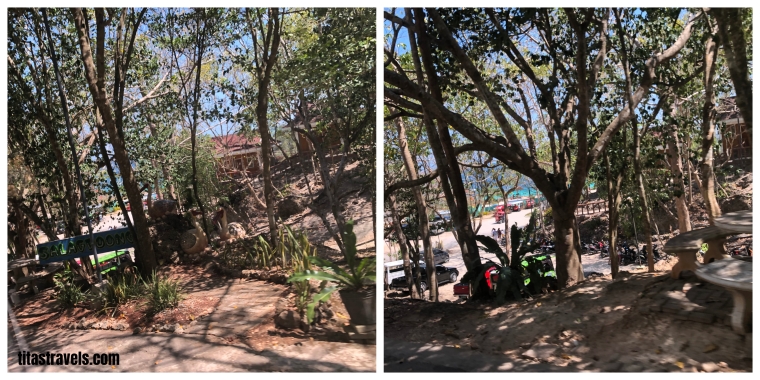 Entrance of Salagdoong Beach from access road
Entrance of Salagdoong Beach from access road
The entrance fee is PHP25 per person (inclusive of a PHP10 environmental fee and PHP5 Red Cross fee) and the parking fee is PHP25.

Our driver, Jimmy, parked the van in a designated area near the individually-roofed tables lining the edge of the paved area by the easement leading to the beach below.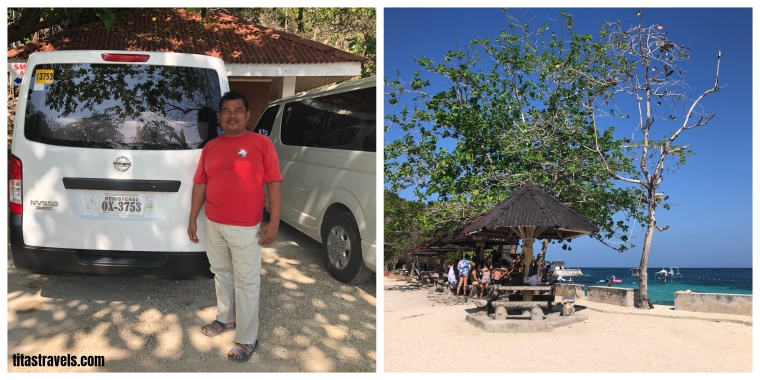
The well-maintained beach offers fine white sand shores and clear blue waters.
You can see several large inflated plastic objects, which, I guess, could be rented and enjoyed by you and your group.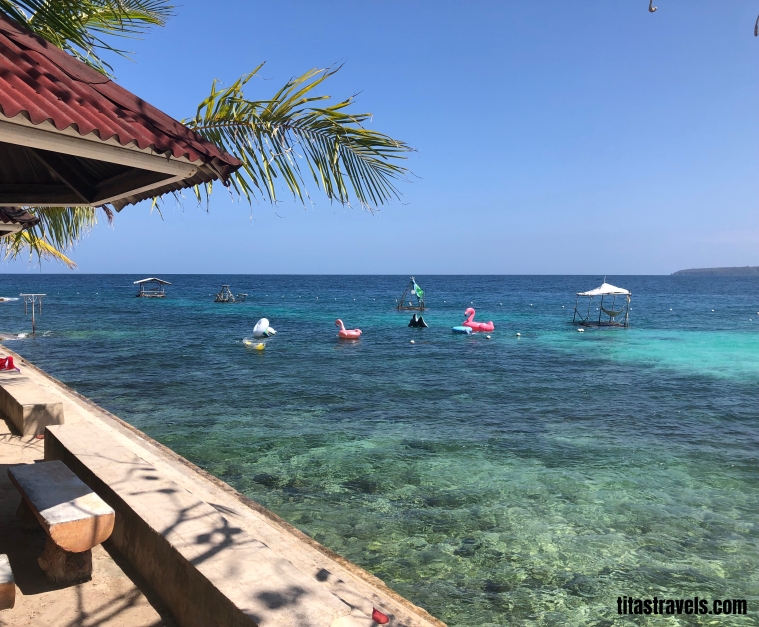
I was also told that the resort offers rooms and cottages with complete amenities to interested guests.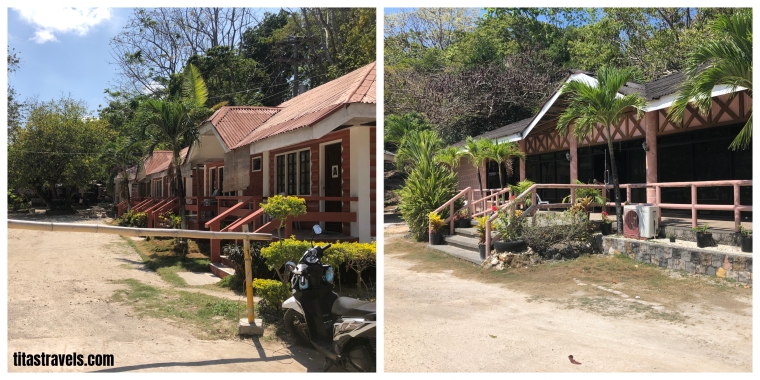
If you walk onwards from the parking area, following the cemented border to the left, you will immediately see a blue painted slide at the far left, but during our visit (March 2019), it was under renovation and cannot be used.
You can head up the cemented steps near the slide till you reach a gazebo-like structure.
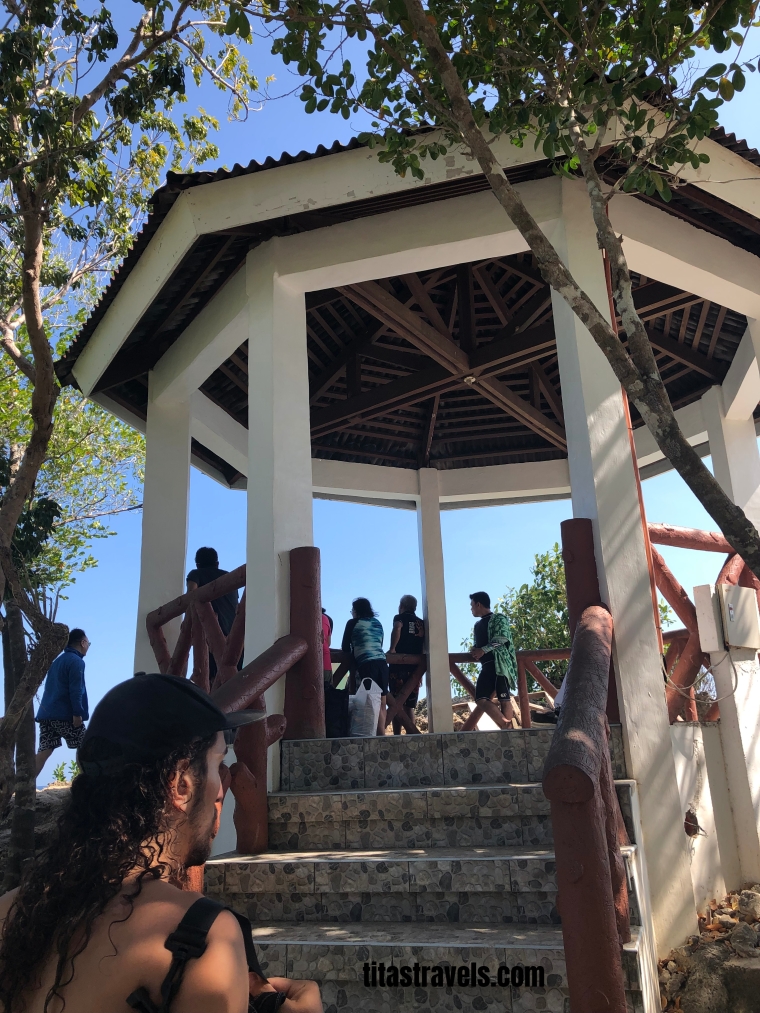
The cliff-diving area is to the far left. You will see two diving boards at different heights, with the left one placed several feet lower than the right one, more than 65 meters in height.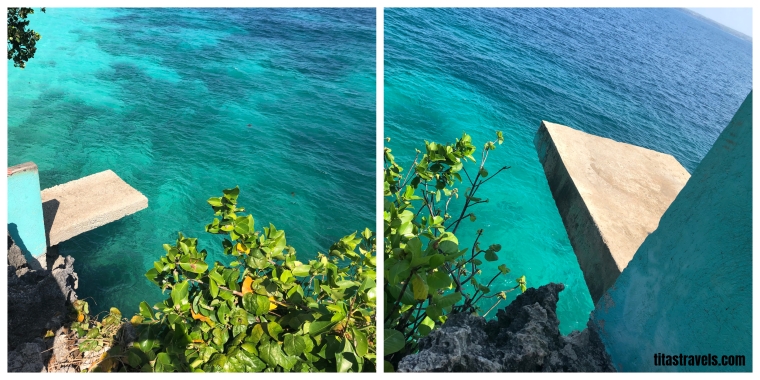
If you are brave enough, you dive and have your picture and video taken by your companion. As for me, I am not that brave, so I just took a picture of the white sand beach from that elevation.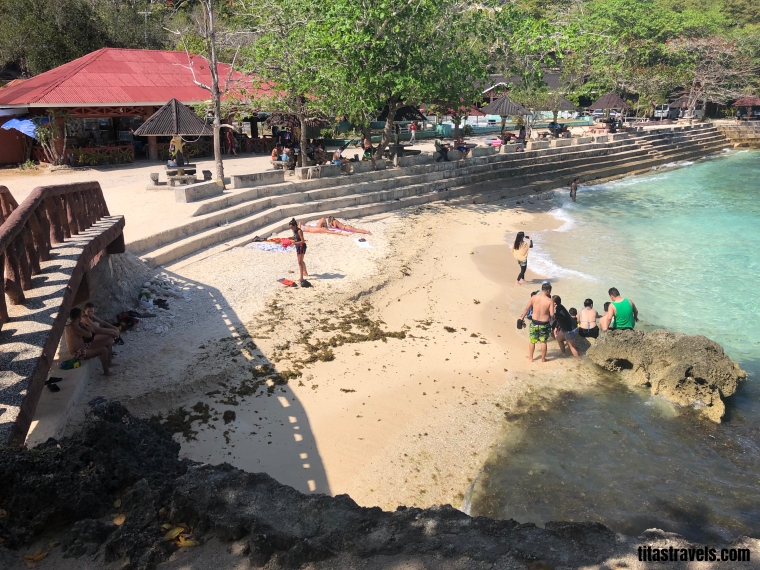
I was also told that there was a tourist who got a minor scratch at the lower cliff-diving area. He hit the rocks at the bottom because his jump was not far enough. So, if you, or one of your companions, decide to cliff-dive, ask if it is high tide, and be sure to jump as far as possible from the board since the water directly below is not that deep. Perhaps, start with the left board, and for more excitement, try the right board too!
For smokers, the rear part of the gazebo is the smoking area.
As you get down from the gazebo, you will see a restaurant-dining area, at about your 11 o’clock position. It was very hot afternoon, and I found my way to the restaurant, went over their menu, and decided to order shakes, a couple of clubhouse sandwiches, and popsicles for the young and young-at-hearts.
The service was slow because of the large volume of tourists, but the helpful and hospitable staff more than compensated for the delay. I was allowed to bring the orders to our shaded table overlooking the secluded beach. The fresh breeze was so nice to enjoy with our light snack. I saw to it that I returned the china and silverware we used.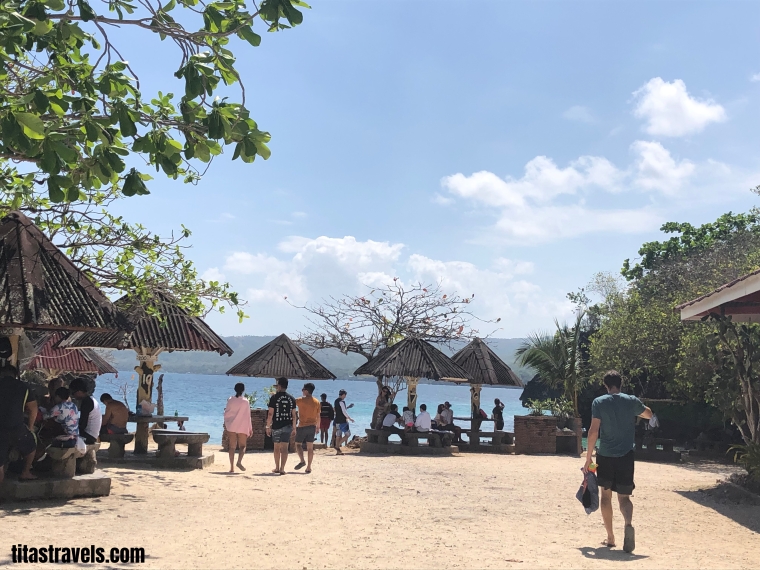
A secluded, partially-shaded beach beckons near the cliff area. This is where local and foreign tourists sit on the sand to sunbathe, or wade in the shallow, clear waters.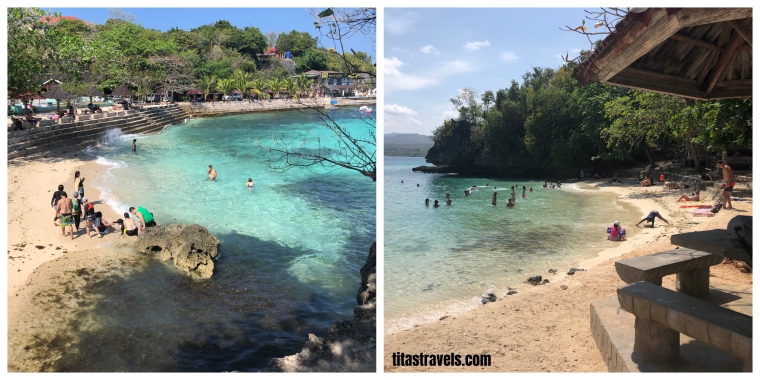
By the way, always secure your belongings by assigning a companion to watch over them while the rest of the group swim, sunbathe, snorkel, or cliff dive. A tourist lost her belongings during our visit.
We only stayed about an hour on this beach. We had to proceed back to the pier for our trip back to Dumaguete7 through Oceanjet8.
This is not a sponsored post. We paid for our Siquijor Coastal Tour and all comments are based on my personal experience in this province1.
You can read related posts about my Siquijor tour: ENCHANTING 400-YEAR-OLD BALETE TREE AND FISH SPA, SIQUIJOR, GET BEWITCHED AT HAPITANAN, SIQUIJOR, TAKE A TARZAN-LIKE DIVE AT CAMBUGAHAY FALLS, SIQUIJOR! and Now You Know – SIQUIJOR: ITS LEGEND, HISTORY, TRADITIONS, AND BELIEFS
Did you find this post informative? I would like to hear from you re your visit to this beautiful beach. Simply scroll and click “Leave a comment”.
See other interesting places through other posts in this category and other categories of SCapades, Pinoy Delights, and Smart Travelers – Foreign Travelers Ask, Now You Know, and Say, Say, Say. Happy reading, and I hope that you will appreciate what I shared and some of the featured destinations will be part of your future travel plans!
Remember to share this post with your friends, follow me by clicking on the bottom right corner of your device, and do not forget to like this post. Thank you.
– – – – – – – – – – – – – – – – – – – – – – – – – –
The following terms are defined for interested readers, especially non-Filipinos, those with “Senior-Moments”, and those too busy or lazy to Google such terms:
1A province is the primary administrative and political division in the Philippines. It is the second-level administrative sub-division of a region9. There are 81 provinces (called “lalawigan”) in the Philippines. Each province is governed by an elected legislature called the Sangguniang Panlalawigan and by an elected governor. In the Philippines, a province is divided into cities10 and municipalities11 (or towns), which in turn, are divided into barangays12, formerly called barrios. The information was obtained from Wikipedia page “Provinces of the Philippines.”13 See a related post: Foreign Seniors Ask: WHAT ARE PROVINCES IN THE PHILIPPINES?
2Siquijor is an island province1 of the Philippines located in the Central Visayas3 Region (Region VII)4. Its capital is the municipality11 which is also called Siquijor. This coralline island is predominantly hilly, and in many places the hills reach the sea, producing steep cliffs. Geographically, Cebu is to the north, Negros to the west, Bohol to the northeast, and to the south, across the Bohol Sea, is Mindanao. It has a long-time reputation as a place of magic, sorcery, and mystical traditions. It is also well known for its festivals that focus on healing rituals.The information was obtained from the Wikipedia page “Siquijor”.14
3Visayas is one of the 3 major geographical divisions of the Philippines. It covers 3 administrative regions9: Central Visayas4, Eastern Visayas and Western Visayas. It consists of 6 major islands (Bohol, Cebu, Leyte, Negros, Panay and Samar), mostly surrounded by the Visayan Sea, and is composed of 16 provinces1, according to Wikipedia page “Visayas”.15 Visayas is located at the middle part of the country; the 2 other geographical divisions of the Philippines are Luzon (in the northern part) and Mindanao (in the southern part).
4Central Visayas (Region VII) of the Philippines is a Philippine region9 located in the island group of Visayas3, with Cebu City as its regional center. It has 7 local government units16 (LGUs): Bohol, Cebu, Cebu City, Lapu-Lapu, Mandaue, Negros Oriental, and Siquijor2. The information was obtained from Wikipedia page “Regions of the Philippines.”17
5Molave is a large Philippine timber tree (Vitex parviflora), known for its dense, durable, yellow wood. It was once used extensively in furniture, boats, etc. as a valuable construction material, but due to habitat loss and overharvesting, it is now classified as endangered by the Philippine Department of Environment and Natural Resources. The information was obtained from Wikipedia page “Vitex parviflora.”18
6Yane’s Adventures Van Services information – Address: Pangi, Siquijor, Siquijor; Contact numbers: 09052133123, 09069732330 and 09183124461, look for Jade Jumawan Pestillos, and request for our very accommodating and cheerful driver, Jimmy Bueno.
7Dumaguete is the capital city10 and main port of Negros Oriental, a province1 in Central Visayas (Region VII)4, of the Philippines. This laid-back university town is called the “City of Gentle People”. It has a charming sea-front boulevard, the most popular destination in the Philippines for retiring abroad, and among the top 10 tourist destinations in the country. The information was obtained from the Wikivoyage page “Dumaguete”.19
8Ocean Jet is the term for the high-speed water craft, owned and operated by Ocean Fast Ferries, Inc., a wholly owned Filipino corporation, offering ferry services to 10 destinations in the Philippines – Bacolod (Negros Occidental), Camotes Island and Cebu City (Cebu), Dumaguete7 (Negros Oriental), Iloilo City (Iloilo), Ormoc (Leyte), Larena (Siquijor2) and Tagbilaran (Bohol), Batangas City (Batangas), and another in Calapan (Oriental Mindoro), with a fleet of 17 vessels. It was founded in 1995, then called Socor Shipping Lines (till 2001), with headquarters in Cebu City. The information was obtained from Wikipedia page “Ocean Fast Ferries.”20 Visit its website: www.oceanjet.net/
9A region is the first-order administrative division in the Philippines. There are 17 regions in the Philippines, based on geographical, cultural and ethnological characteristics. It is further subdivided in provinces1, composed of cities and municipalities11 (or towns), which in turn, are divided into barangays12. The regions were initially identified in 1972, through Presidential Decree No. 1 of President Ferdinand Marcos. Since then, other regions have been created and some provinces have been “transferred” to another region. The information was obtained from Wikipedia page “Regions of the Philippines.”17 See a related post: Foreign Seniors Ask: WHAT ARE THE REGIONS OF THE PHILIPPINES?
10A city is the local government unit16 in the Philippines headed by a mayor elected by popular vote. A vice-mayor serves as the presiding officer of the city’s legislative body – the Sangguniang Panlungsod (city council). The information was obtained from Wikipedia page “Cities of the Philippines.”21 See a related post: Foreign Seniors Ask: HOW MANY CITIES ARE THERE IN THE PHILIPPINES?
11A municipality is a small, single urban administrative division, or local government unit (LGU)16, in the Philippines which has corporate status and powers of self-government or jurisdiction as granted by law. It is a unit under a province1, subdivided into barangays12, and is called town, or bayan. In the Philippines, a municipality is headed by a mayor, a vice mayor and members of the Sangguniang Bayan (legislative branch). It can enact local policies and laws, enforce them, and govern its jurisdictions. It can enter into contracts and other transactions through its elected and appointed officials, and can tax as well. It enforces all local and national laws. The information was obtained from Wikipedia page “Municipalities of the Philippines.”22
12A barangay in the Philippines is the smallest administrative division in the Philippines, headed by a barangay captain, aided by a Sangguniang Barangay (Barangay Council). It is the native Filipino term for a district or village. It was formerly called a barrio. In a metropolitan area, a barangay is an inner city neighborhood, a suburb, or a suburban neighborhood. The word barangay originated from the term “balangay”, a kind of boat used by a group of Austronesian people who migrated to the Philippines.A number of barangays grouped together is called a district. The information was obtained from Wikipedia page “Barangay.”23
13“Provinces of the Philippines,” accessed July 17, 2018, https://en.wikipedia.org/wiki/Provinces_of_the_Philippines
14“Siquijor,”accessed October 16, 2018, https://en.m.wikipedia.org/wiki/Siquijor
15“Visayas,” accessed January 29, 2019, https://en.wikipedia.org/wiki/Visayas
16A local government unit (LGU) in the Philippines is divided into 3 levels: provinces1 and independent cities24; component cities25 and municipalities11; and, barangays12, according to Wikipedia page “Local government in the Philippines”.26
17“Regions of the Philippines,” accessed January 29, 2019, https://en.wikipedia.org/wiki/Regions_of_the_Philippines
18“Vitex parviflora,” accessed March 8, 2019,https://en.wikivoyage.org/wiki/Vitex_parviflora
19“Dumaguete,” accessed March 8, 2019,https://en.wikivoyage.org/wiki/Dumaguete
20“Ocean Fast Ferries,” accessed January 29, 2019, https://en.wikipedia.org/wiki/Ocean_Fast-Ferries
21“Cities of the Philippines,” accessed January 29, 2019, https://en.wikipedia.org/wiki/Cities_of_the_Philippines
22“Municipalities of the Philippines,” accessed January 29, 2019, https://en.wikipedia.org/wiki/Municipalities_of_the_Philippines
23“Barangay,” accessed January 29, 2019, https://en.wikipedia.org/wiki/Barangay
24An independent city is a type of city10 in the Philippines which is administratively and legally not subject to a province1so it does not share its tax revenues with any province. The national government and its agencies serve such a city through sub-offices of the region9 it belongs to. It is subdivided into 2: highly urbanized city27or independent component city28. The information was obtained from Wikipedia page “Cities of the Philippines”21
25A component city is a type of city10 in the Philippines which does not meet the requirements of a highly urbanized city27. It is under the jurisdiction of a province1. If such a city is located along the boundaries of 2 or more provinces, it shall be considered part of the province of which it used to be a municipality11. The information was obtained from Wikipedia page “Cities of the Philippines”21
26“Local government in the Philippines,” accessed July 17, 2018, https://en.wikipedia.org/wiki/Local_government_in_the_Philippines
27A highly urbanized city (HUC) is a type of city10 in the Philippines with a minimum population of 200,000 as certified by the Philippine Statistics Authority (PSA), and with the latest annual income of at least 50 million pesos, according to Wikipedia page “Cities of the Philippines”.21 There are currently 33 such cities in the Philippines (see link – I will place a link here).
28An independent component city (ICC) is a type of city10 in the Philippines which is autonomous from the province1 in which it is geographically located and has a charter that explicitly prohibits its residents to vote for provincial officials (unless allowed to do so). It does not meet the requirements of a highly urbanized city27. There are 5 such cities in the country: Cotabato, Dagupan, Naga, Ormoc, and Santiago. The information was obtained from Wikipedia page “Cities of the Philippines”21



 Checawey, 18 February 2012,
Checawey, 18 February 2012, 


